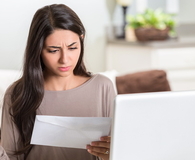7 Modern Ways to Balance Your Checkbook
I remember watching my mom sit at the kitchen table at the end of each month, examining a checkbook ledger and paper statement from the bank. It was time to balance the checkbook — an essential task for any family looking to accurately track spending, avoid overdrafts, and stay on budget.
Balancing your checkbook is still practiced in some circles. It's akin to how some people still listen to compact discs or carry around flip phones. But these days, balancing your checkbook manually isn't nearly as essential due to advancements in technology and changes to our financial habits.
It's still necessary to make sure you're tracking withdrawals and deposits and staying on top of your checking account balance. So how do we do it? Check out these ways to balance your checkbook in the modern age.
1. Use online banking
These days, every bank encourages you to sign up for their online banking service. In fact, many modern banks don't have physical branches at all. Online banking gives you a real-time look at your money, so you know if payments and deposits are processed correctly. It's easy to check balances, transfer funds, and pay bills. There's no waiting around for monthly statements; you can look immediately to see if a transaction cleared, and you'll notice any errors immediately. (See also: 5 Best Online Savings Accounts)
2. Use smartphone apps
If you have online banking, most banks also offer smartphone apps with the same functionality as their websites. Many of them also allow you to deposit checks by sharing an image. Other apps like Clarity Money and Wally will also help you track spending money so you know precisely what's going in and out at any given time. (See also: These 5 Apps Will Help You Finally Organize Your Money)
3. Get text alerts
If you really want to stay on top of every dollar that goes in and out, you can use online banking apps to set up text alerts for when transactions post. You can get text alerts for when your balance dips below a certain limit, or when you face a possible overdraft charge. You'll know the very second when a check clears or when a bill is paid, so you're never confused about where you stand financially. It's also possible to get fraud alerts via text.
4. Automate everything
It's possible these days to send paychecks directly to your bank account through direct deposit, and also set up bills to pay automatically as well. It's may not be possible to automate everything, but the bulk of your income and most of your major bills (mortgage, loan payments, utilities, etc.) can all be sent directly from your bank account with no check required.
You can even select the dates when you want money to go out. This means you will never miss a bill, and the possibility of error is very small. Automate enough, and you may be able to "set and forget" a lot of your monthly transactions. (See also: 5 Ways to Automate Your Finances)
5. Use an account aggregator
If you want to see your full financial picture in one place, websites and apps such as Mint.com and Personal Capital will let you aggregate your accounts into a single view. These sites let you see everything from bank accounts to investment portfolios, loans, and even college savings accounts. Did you transfer money from your checking account to your brokerage account? Did you pull money from your online savings account to make an extra mortgage payment? These sites don't miss a thing.
6. Use Quicken or similar programs
If you still want to feel directly engaged with your finances by entering transactions, you can do so on the computer online through any number of accounting programs. Quicken may be the most popular, but there are other tools such as GnuCash and You Need a Budget that have similar capabilities.
7. Avoid checks if possible
One of the key reasons people have balanced checkbooks manually in the past is that it allowed them to keep track of checks that had not yet cleared. But if you never use checks to pay for things, this is not as much of an issue. Nowadays, you can use credit or debit cards for many purchases, or use services such as PayPal or Venmo that allow for instant transfers of cash.
Like this article? Pin it!
Disclaimer: The links and mentions on this site may be affiliate links. But they do not affect the actual opinions and recommendations of the authors.
Wise Bread is a participant in the Amazon Services LLC Associates Program, an affiliate advertising program designed to provide a means for sites to earn advertising fees by advertising and linking to amazon.com.



















